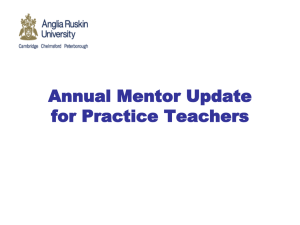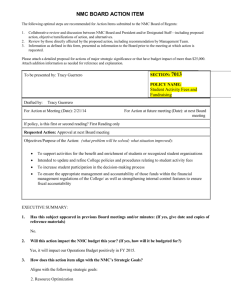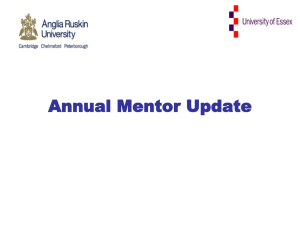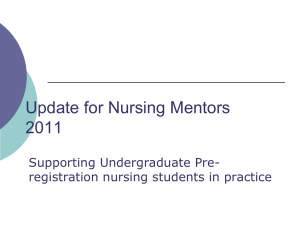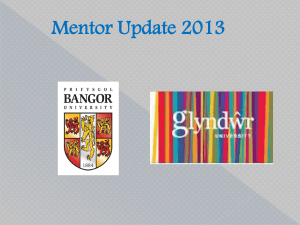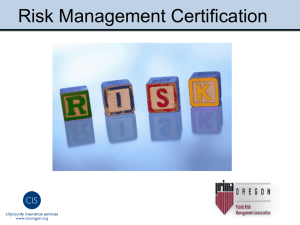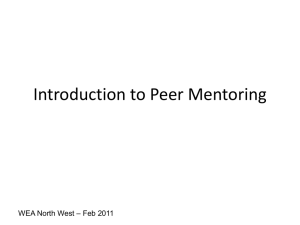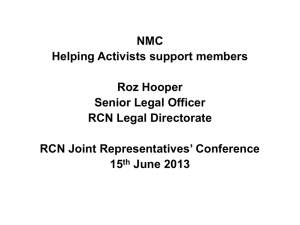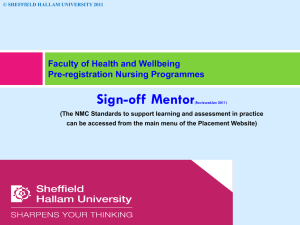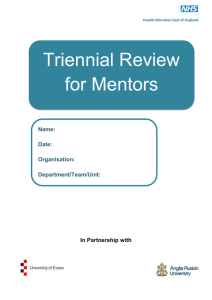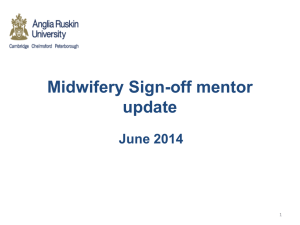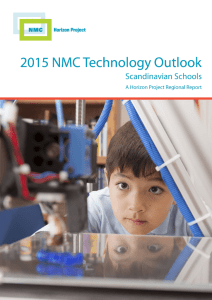Stage 2
advertisement
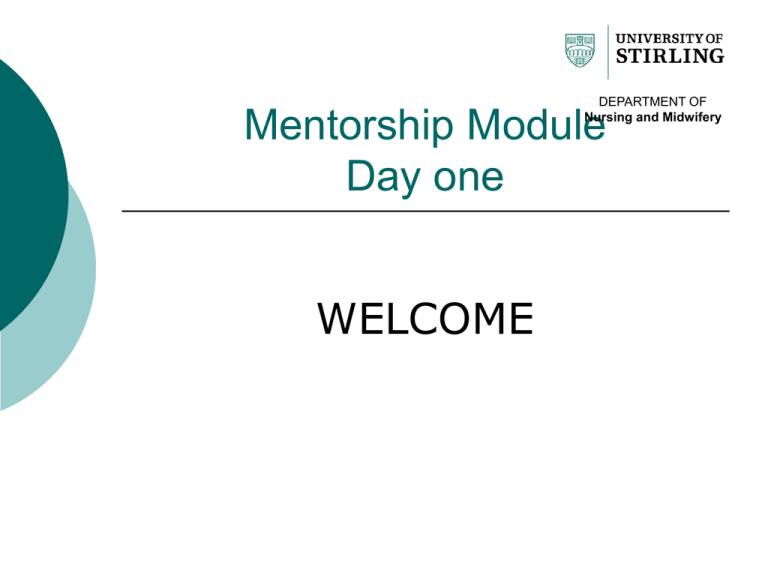
DEPARTMENT OF Nursing and Midwifery Mentorship Module Day one WELCOME Outline of the Day Introductions Ground Rules and Expectations Organisation of Module NMC Standards Definition of Mentor Teaching and Learning Website-(Supervisor Mentors) Portfolio of Evidence-(Supervisor Mentors) Organisation of the Module 3 days face to face 2 days protected time with work based activities 5 days unprotected time with work based activities Accredited or non-accredited routes Accredited route = 11 credits – level 9 NMC Standards to support learning & assessment in practice. (2008) 1 2 5 3 6 4 7 8 Stage 1: Registrant Stage 2: Mentor Stage 3: Practice Teacher Stage 4: Teacher NMC Domains Domains to be achieved according to the standard: o o o o o o o o Establishing effective working partnerships Facilitation of learning Assessment and accountability Evaluation of learning Creating an environment for learning Context of practice Evidence based practice Leadership (NMC, 2008) Role of Mentor o Work with others to protect and promote the health and wellbeing of those in your care, their families and carers, and the wider community. Share information with your colleagues You must facilitate students and others to develop their competence. You must be willing to share your skills and experience for the benefit of your colleagues. (NMC The Code 2008, p 5) Requirements of the Standard ه NMC Standards to Support learning and assessment in practice; NMC standards for mentors, practice teachers and teachers (2008.19) “An NMC Mentor is a registrant who, following successful completion of an NMC approved mentor preparation programme- or comparable preparation that has been accredited by an AEI as meeting the NMC Mentor requirements-has achieved the knowledge, skills and competence required to meet the defined outcomes.” Learning and Teaching Characteristics of a mentor Role and characteristics of a mentor In groups discuss these and identify the above. Feedback – identify strengths and areas requiring further development Learning and Teaching Student/ Learner Characteristics Overview of Learning Theories: Pedagogy- behaviourism cognitivism constructivism Andragogy-humanism Student/ Learner Characteristics Overview of Learning Theories: Divide into small groups Review literature on learning theories: Feedback on the broad aims of a theory and state the relevance to your practice Learning Styles Review different ways that students learn: Activists Reflectors Theorist Pragmatists ( Honey and Mumford 1994 ) Deep and Surface Learners (Entwhistle N 1997) Levels of Learners Identify the different types of learners you encounter in your placement area Pre-registration nursing students - Years 1, 2 & 3 NHS HNC Healthcare students/HNC Healthcare students Midwifery Students - Pre & Post-registration SVQ students Flying Start practitioners Multi professional students Colleagues – professional development Discussion of different expectations at different levels Discuss different types of learners- eg previous experience Preparing for students/learners What you would like to know? Previous experience Skills already achieved Theoretical knowledge http://www.nm.stir.ac.uk/mentors/ind ex.php Preparing for students/learners Jean a module 2 student is coming to your placement area in 6 weeks time. Discuss in small groups what information you would like to have for this student coming. What preparation is required for the arrival of the student and what you would discuss on her first day. Planning Consider length of time student is allocated Check off-duty if any A/L how do you ensure continuity for the student Review learning opportunities available What would you expect the student to do at which point of their allocation The Learning Environment Learning Opportunities from various clinical areas are available. In small groups choose 2 domains and document learning opportunities appropriate to your clinical area The Learning Environment Inclusive هSupportive هPlanned هStudents objectives to fit into designated area Swot Analysis Within the evaluation of your placement include consideration of Interprofessional and Professional issues Strengths, Weaknesses Opportunities, Threats (SWOT) analysis Evaluating your learning environment Consider your work environment considering the following practical experience practice resources learning support Approach to education Further guidance is available Price B 2004 Mentoring learners in practice; Evaluating your learning environment Nursing Standard, Oct. 13 Vol.19 No.5 Orientation Have you considered an educational day for students on their first day of placement? Induction- what areas do you cover? University induction process. Some areas will have their own generic induction for any new learner Confidentiality Health and Safety Local polices and procedures Uniform code Interviewing students - initial meetings Preparation- do you have accommodation, privacy, allocated time Materials- student documentation, action plan and learning opportunities for students at the appropriate level for their training Communication and developing mentor/student relationship Refer to Practice Based Learning – pg 7-10 http://www.practicebasedlearning.org/resou rces/materials/docs/Brookes%20Final.pdf Learning Contract Placement Development Plan (university student learning contract- discuss link to LO’s/SOP’s) What are the facilitation skills required by the mentor to assist the student to achieve this Review facilitation section – Making Practice Based Learning Work Pg 18-22 Organisation of the Module 3 days face to face 2 days protected time with work based activities 5 days unprotected time with work based activities Accredited or non-accredited routes Accredited route = 11 credits – level 9 Portfolio of evidence Documentation required; o Learning contract / Action Plan o Record of Interim and Final Reviews o Record of Completion of Module Component Forms o Log of Practice Hours- containing a minimum of 37 and a half hours on specific practice mentor activity o Mapping of Portfolio of Evidence against Domains/ Outcomes o Verification of Achievement of Mentor Outcomes The Accredited Version of the Module Also requires o From the “ Record of Completion “ forms, 2 specific components will be chosen for expansion with 1250 word essays. The 2 components will vary for each module o An assignment cover sheet should completed for submission with the expanded portfolio NMC Standards to support learning & assessment in practice. (2008) 1 2 5 3 6 4 7 8 Stage 1: Registrant Stage 2: Mentor Stage 3: Practice Teacher Stage 4: Teacher NMC Domains Domains to be achieved according to the standard: o o o o o o o o Establishing effective working partnerships Facilitation of learning Assessment and accountability Evaluation of learning Creating an environment for learning Context of practice Evidence based practice Leadership (NMC, 2008) Mapping to Standard This Mentorship Module maps to: - NMC Mentor Outcomes - NES Framework Learning outcomes - NES Framework Unit Learning Outcomes - Knowledge and Skills Framework Core Dimensions Achieving the Appropriate Academic level Mentor module is developed at Academic Level 9 Explain SCQF levels Define and give examples of learning at level 9
